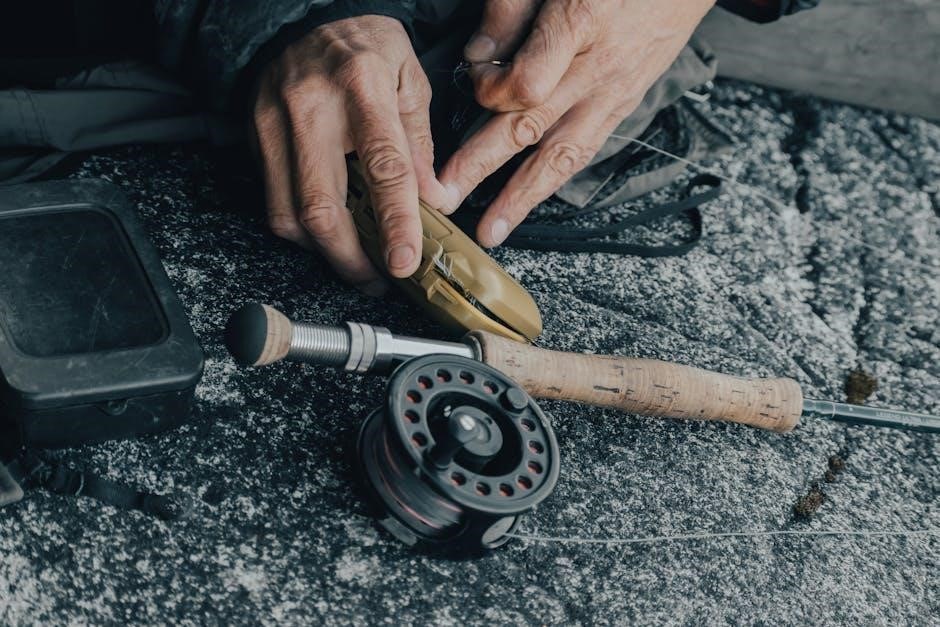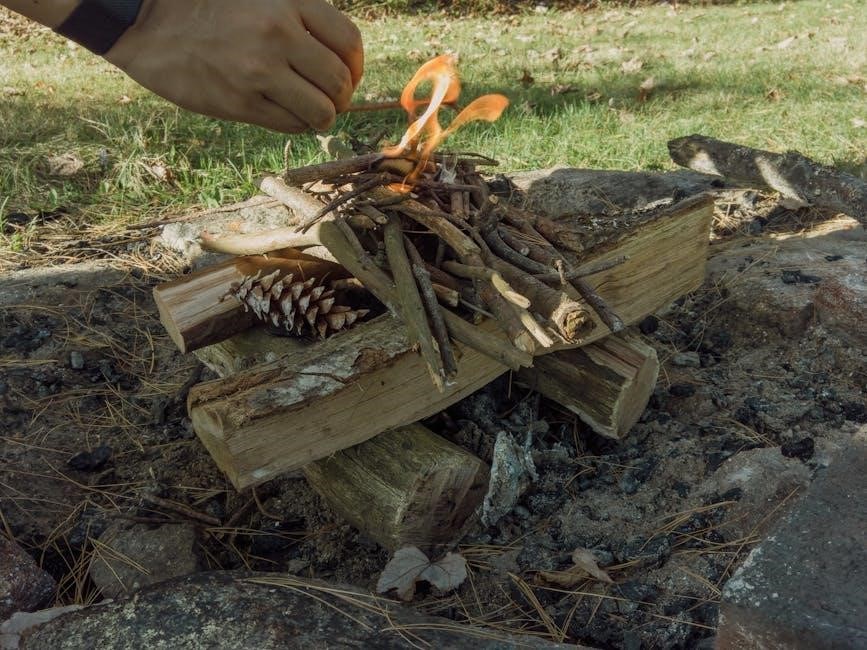Welcome to the Vermont Castings Vigilant manual! This guide introduces you to a high-efficiency stove designed for reliable heating․ Discover its features, operation, and maintenance for optimal performance․
1․1 Overview of the Vermont Castings Vigilant
The Vermont Castings Vigilant is a high-efficiency stove designed for reliable heating performance․ Built with durable materials, it combines traditional design with modern technology to ensure consistent warmth․ Its robust construction and user-friendly controls make it a popular choice for homeowners seeking a dependable heating solution․ The Vigilant model is known for its large firebox capacity and advanced combustion system, which maximizes fuel efficiency and reduces emissions․ This stove is ideal for those looking to blend functionality with classic aesthetics in their home heating setup․
1․2 Importance of the Manual
This manual is essential for understanding and operating the Vermont Castings Vigilant safely and effectively․ It provides detailed instructions for installation, operation, and maintenance, ensuring optimal performance․ By following the guidelines, users can maximize efficiency, minimize risks, and prolong the stove’s lifespan․ The manual also includes troubleshooting tips and safety precautions, making it a vital resource for homeowners․ Proper use of this guide helps users achieve reliable heating while maintaining safety standards and compliance with manufacturer recommendations․

Product Specifications
The Vermont Castings Vigilant is a high-efficiency stove designed for reliable heating․ It features advanced fuel efficiency, robust construction, and precise temperature control, ensuring optimal performance and durability․
2․1 Key Features of the Vigilant Model
The Vermont Castings Vigilant model stands out with its high-efficiency combustion system, ensuring maximum heat output while minimizing fuel consumption․ It features a durable cast iron construction, known for its longevity and heat retention․ The stove incorporates an advanced air wash system to maintain a clear glass window, offering an unobstructed view of the flames․ Additionally, it includes adjustable dampers for precise control over airflow and burn rates, allowing for tailored heating performance․ These features collectively contribute to a reliable and efficient heating solution for any home․
2․2 Technical Details
The Vermont Castings Vigilant is designed with precision engineering, featuring a robust cast iron construction for durability and heat retention․ It operates on wood fuel, achieving an efficiency rating of up to 85% due to its advanced combustion technology․ The stove is EPA-certified, ensuring low emissions and environmental compliance․ With a maximum output of 40,000 BTUs, it is suitable for medium to large spaces․ The Vigilant model includes a secondary combustion system for complete fuel burning, reducing smoke and creosote buildup․ Its ignition system is user-friendly, and it is compatible with standard venting kits for safe installation․
2․3 Dimensions and Weight
The Vermont Castings Vigilant stove measures approximately 30 inches in width, 36 inches in height, and 24 inches in depth, making it a compact yet efficient heating solution․ It weighs around 400 pounds, ensuring stability and durability․ These dimensions are crucial for proper installation and ensure the stove fits seamlessly into various spaces․ The weight also contributes to heat retention, allowing for consistent warmth distribution․ These specifications are essential for planning and executing a safe and effective installation, ensuring optimal performance and safety in your home․

Safety Precautions
- Always follow proper installation and operating guidelines to ensure safety․
- Keep flammable materials at least 3 feet away from the stove․
- Ensure proper ventilation to prevent carbon monoxide buildup․
- Supervise children and pets near the stove at all times․
3․1 General Safety Guidelines
Always read and follow the Vermont Castings Vigilant manual carefully before installation or use․ Ensure the stove is installed by a qualified professional to meet local safety codes and regulations․ Keep the stove and surrounding area clear of flammable materials, such as curtains or rugs․ Maintain a safe distance from the stove to avoid burns․ Never leave children or pets unattended near the stove․ Store fuel and ashes in a safe, well-ventilated area away from living spaces․ Regularly inspect the stove and venting system for damage or blockages․ Follow all manufacturer recommendations for operation and maintenance to ensure safe and efficient performance․
3․2 Handling and Installation Safety
Wear protective gloves and eyewear when handling the Vermont Castings Vigilant to avoid injury from sharp edges or debris․ Ensure the stove is placed on a stable, heat-resistant surface during installation․ Never lift the stove by its doors or glass panels, as this may cause damage or personal injury․ Use proper lifting techniques to avoid back strain․ Ensure all connections, such as venting and fuel lines, are securely tightened to prevent leaks․ Only authorized personnel should handle the stove during installation to ensure compliance with safety standards and manufacturer guidelines․
3․3 Operating Safety Tips
Always keep flammable materials at least 3 feet away from the stove while in operation․ Never leave the stove unattended when burning․ Ensure children and pets are supervised to avoid accidental contact․ Maintain proper airflow by keeping vents clear and unobstructed․ Avoid burning wet or unseasoned wood, as it produces less heat and more smoke․ Use a fireplace screen to contain sparks and embers․ Never burn trash, plastics, or treated wood, as they release toxic fumes․ Keep a fire extinguisher or water source nearby in case of emergencies․ Always follow the manufacturer’s guidelines for safe operation․

Installation and Assembly
Installation and assembly require careful planning and adherence to manufacturer guidelines to ensure safety and proper functioning of the Vermont Castings Vigilant․
4․1 Pre-Installation Requirements
Before installing the Vermont Castings Vigilant, ensure the location meets safety and regulatory standards․ Choose a well-ventilated area away from flammable materials․ Check local building codes for specific requirements․ Gather necessary tools and materials, such as a chimney liner and installation hardware․ Prepare the site by leveling the floor and ensuring proper drainage․ Verify compatibility of the unit with existing heating systems․ Refer to the manufacturer’s guidelines for precise measurements and clearances to avoid installation errors․
4․2 Step-by-Step Assembly Instructions
Begin by unpacking and inspecting all components for damage․ Connect the burner assembly to the base unit, ensuring proper alignment․ Install the grate and firebrick according to the manual’s diagram․ Attach the control panel securely, connecting all wiring harnesses․ Mount the venting system, ensuring airtight seals․ Install the handle and trim for safe operation․ Double-check all connections for leaks or misalignment․ Refer to the manual for specific torque settings and part numbers․
4․3 Venting and Clearance Guidelines
Proper venting is crucial for safe and efficient operation․ Ensure the venting system meets local codes and manufacturer specifications․ Install vents with a minimum height of 12 feet above the roofline for optimal draft․ Maintain a minimum clearance of 6 inches from combustible materials․ Use only approved, corrosion-resistant venting materials․ Avoid horizontal runs exceeding 10 feet to prevent performance issues․ Keep vents clear of obstructions and ensure proper sealing to prevent gas leaks․ Consult local regulations for additional requirements․
Operating Instructions
Follow the ignition process carefully and monitor performance․ Adjust settings as needed for optimal heat output․ Ensure proper airflow and maintain safe operating practices at all times․
5․1 Ignition and Startup Process
Ensure the stove is properly installed and clear of obstructions․ Open the damper fully and check the chimney for blockages․ Place kindling and tinder in the firebox, following the manufacturer’s guidelines․ Light the fire using a match or ignition source․ Gradually add larger logs once the fire is burning steadily․ Always refer to the manual for specific ignition instructions to ensure safe and efficient operation․ Allow proper airflow during startup to establish a strong draft․ Monitor the flame height and adjust as needed for optimal performance․
5․2 Temperature Control and Adjustment
Temperature control on the Vermont Castings Vigilant is managed primarily through airflow adjustments․ Opening or closing the dampers and vents regulates oxygen flow to the fire, with more oxygen leading to a hotter burn and less oxygen resulting in a cooler, slower burn․ The size of the wood also plays a role, as smaller logs burn hotter and faster, while larger logs provide a more consistent, lower heat․ Ensuring proper chimney draft is essential for efficient burning․ If equipped, a thermostat can help maintain a set temperature automatically․ Always follow manual guidelines for safe temperature adjustments to prevent overheating and ensure optimal performance․
5․3 Monitoring and Maintaining Optimal Performance
To ensure the Vermont Castings Vigilant operates at its best, regular monitoring is essential․ Check for proper airflow by inspecting venting systems for blockages․ Clean the baffle and combustion chamber periodically to maintain efficiency․ Inspect door and glass gaskets for wear, replacing them if necessary․ Monitor burn times and adjust fuel sizes as needed․ Keep the chimney clean to prevent creosote buildup, which can hinder performance․ Regularly check for any unusual sounds or odors, as they may indicate maintenance needs․ Consistent upkeep ensures safety, efficiency, and reliable operation․

Fuel Types and Usage
The Vermont Castings Vigilant is designed to burn wood efficiently․ Use seasoned, dry hardwood for optimal performance․ Avoid softwoods and non-recommended fuels to ensure safety and efficiency․
6․1 Recommended Fuel for the Vigilant
The Vermont Castings Vigilant is optimized for burning seasoned, dry hardwood․ Oak, maple, and ash are ideal choices due to their high energy content and efficient combustion․ Softwoods, like pine, should be avoided as they produce less heat and more creosote․ Ensure wood has a moisture content below 20% for optimal performance․ Avoid burning treated or painted wood, as it releases harmful chemicals․ Proper fuel selection ensures safety, efficiency, and reduces maintenance, aligning with the stove’s design for clean, reliable heat production․ Always follow local regulations regarding fuel sources and emissions․
6․2 Fuel Efficiency and Consumption Rates
The Vermont Castings Vigilant is designed for high fuel efficiency, achieving an EPA-certified rating of 78% efficiency․ It burns approximately 3-5 pounds of wood per hour, depending on the heat output setting․ The stove’s advanced combustion system ensures minimal fuel waste, maximizing heat production․ At optimal operation, it can provide up to 40,000 BTUs per hour․ Fuel consumption rates vary based on burn time, wood moisture, and airflow settings․ Proper maintenance and seasonal adjustments help maintain its efficient performance․ Always monitor fuel usage to ensure maximum energy output and cost-effectiveness․

Troubleshooting Common Issues
Identify issues like poor draft, low heat, or smoke leaks․ Check venting, ensure proper wood moisture, and inspect door gaskets for tight seals․ Address promptly for optimal performance․
7․1 Identifying Common Problems
Common issues with the Vermont Castings Vigilant include poor draft, low heat output, and smoke leaks․ Users may also experience clogged vents, ignition difficulties, unusual noises, and excessive creosote buildup․ Identifying these problems early is crucial for maintaining efficiency and safety․ Failure to address them can lead to reduced performance and potential safety hazards․ Always refer to the manual for specific guidance on recognizing these issues promptly and ensuring safe operation․
7․2 Diagnostic Techniques
Diagnosing issues with the Vermont Castings Vigilant involves a systematic approach․ Start with a visual inspection of vents, chimneys, and connections for blockages or damage․ Listen for unusual noises, such as rattling or hissing, which may indicate loose parts or air leaks․ Use a manometer to test draft pressure, ensuring it falls within the recommended range․ Check the fuel quality and ensure proper installation of components․ Refer to the troubleshooting chart in the manual for guidance on specific symptoms and potential causes․
7․3 Solutions for Frequent Malfunctions
Common issues with the Vermont Castings Vigilant can often be resolved with simple adjustments․ For poor draft, ensure vents and chimneys are clear of obstructions․ If ignition is inconsistent, clean the burner orifice and check for proper gas flow․ Excessive smoke may indicate improper fuel-to-air ratios; adjust the damper or ensure adequate ventilation․ For overheating, reduce fuel input or improve airflow․ Regular maintenance, such as cleaning and inspecting components, can prevent many malfunctions․ Always refer to the troubleshooting chart for specific solutions․

Maintenance and Upkeep
Regular maintenance ensures optimal performance and longevity․ Clean soot and creosote buildup, inspect and replace worn parts, and perform annual inspections for damage or wear․
8․1 Routine Cleaning Procedures
Regular cleaning is essential for maintaining efficiency and safety․ Clean the firebox, heat exchanger, and glass surfaces after each use․ Use a wire brush to remove soot and creosote buildup from internal components․ Vacuum ash and debris thoroughly, ensuring all vents and chimneys are clear․ For exterior surfaces, use a mild soap solution to wipe down metal parts․ Avoid abrasive cleaners to prevent damage․ Proper cleaning prevents corrosion and ensures optimal airflow and combustion efficiency throughout the heating season․
8․2 Part Replacement and Lubrication
Replace worn-out gaskets, seals, and ignition components annually or as needed․ Inspect the blower and igniter for wear; replace them if damaged․ Lubricate moving parts like hinges and blowers with silicone-based spray to ensure smooth operation․ Avoid petroleum-based lubricants, as they may degrade components․ Regularly check for loose connections and tighten them․ Replace any corroded or damaged metal parts promptly to maintain efficiency and safety․ Keep spare parts on hand to minimize downtime during heating seasons․
8․3 Annual Inspection Checklist
Conduct a thorough annual inspection to ensure optimal performance and safety․ Inspect the venting system for blockages, damage, or leaks․ Check the combustion chamber and heat exchanger for signs of wear or corrosion․ Examine gaskets and seals for integrity and replace if necessary․ Test the blower and fan for proper operation․ Inspect ignition components for wear and functionality․ Verify that all controls and thermostats are functioning correctly․ Check the exterior for damage and ensure the base is level and stable․ Address any issues promptly to maintain efficiency and safety․

Warranty and Support
Vermont Castings offers a comprehensive warranty for the Vigilant model, covering defects in materials and workmanship․ Dedicated customer support is available for inquiries and assistance․
9․1 Understanding the Warranty Coverage
The Vermont Castings Vigilant is backed by a limited warranty that covers defects in materials and workmanship for a specified period․ The warranty typically includes: coverage for parts and labor, with certain conditions․ Key aspects: the warranty is non-transferable and applies to original purchasers only․ Exclusions: damage from misuse, improper installation, or failure to maintain the product․ Duration: varies by component, with major parts often covered for 5 years․ Always refer to the official documentation for exact terms and conditions․ Proper registration may be required to validate the warranty․
9․2 Customer Support Contact Information
For assistance with the Vermont Castings Vigilant, contact customer support at 1-800-578-5331 (Monday–Friday, 8 AM–5 PM EST)․ Email inquiries can be sent to customer․service@vermontcastings․com․ Visit their official website at www․vermontcastings․com for resources, troubleshooting guides, and parts ordering․ Mailing address: Vermont Castings, 4450 Williston Rd, Williston, VT 05495․ Support is available for troubleshooting, warranty claims, and general product inquiries․
Accessories and Upgrades
Explore compatible accessories like heat shields, ducting kits, and blower fans․ Upgrade options include advanced remote controls, high-efficiency burners, and decorative trim kits for enhanced performance and aesthetics․
10․1 Compatible Accessories
The Vermont Castings Vigilant supports various accessories to enhance functionality and convenience․ Compatible items include heat shields, venting kits, and blower fans for improved airflow․ Remote control units and programmable thermostats are also available for precise temperature management․ Additional accessories like decorative trim kits and hearth pads can customize the appearance․ Ensure all accessories are approved by the manufacturer to maintain safety and warranty compliance․ These additions can optimize performance and personalize your heating experience while adhering to safety standards․
10․2 Upgrade Options for Enhanced Performance
The Vermont Castings Vigilant can be enhanced with upgrades to improve efficiency and functionality․ High-efficiency burners and advanced ignition systems are popular upgrades, reducing fuel consumption and emissions; Programmable thermostats and smart home integration offer precise temperature control․ Heat distribution kits can improve warmth circulation in larger spaces․ Upgrading to ceramic glass doors enhances visibility and durability․ Additionally, modern control panels provide a sleek, user-friendly interface․ These upgrades not only boost performance but also align with energy-saving goals, ensuring optimal heating while maintaining the stove’s reliability and charm․ Professional installation is recommended for safety and warranty compliance․

Energy Efficiency and Environmental Impact
The Vermont Castings Vigilant is designed to minimize environmental impact with efficient burn technology, reducing emissions and fuel consumption while providing consistent heat output․
11․1 Energy Efficiency Ratings
The Vermont Castings Vigilant boasts an impressive Annual Fuel Utilization Efficiency (AFUE) rating, ensuring optimal energy use and lower heating costs․ Its advanced combustion technology minimizes fuel waste, achieving high efficiency levels even in colder climates․ This stove is EPA-certified, meeting strict environmental standards for emissions and energy performance․ With its efficient design, the Vigilant reduces energy consumption while maintaining consistent heat output, making it a cost-effective and eco-friendly choice for home heating․
11․2 Environmental Benefits of the Vigilant
The Vermont Castings Vigilant is designed with environmental responsibility in mind, offering cleaner burning technology that significantly reduces emissions․ By meeting or exceeding EPA standards, this stove minimizes its ecological footprint․ Its efficient fuel combustion ensures fewer pollutants are released into the atmosphere, promoting better air quality․ Additionally, the Vigilant’s energy-efficient operation reduces overall fuel consumption, contributing to a lower carbon footprint․ This makes it a sustainable and environmentally friendly option for home heating, aligning with eco-conscious values and reducing environmental impact effectively․

Appendices
This section provides supplementary materials, including detailed technical specifications, a comprehensive parts diagram, and a troubleshooting reference chart for easy maintenance and repair guidance․
12․1 Technical Specifications
This section outlines the detailed technical specifications of the Vermont Castings Vigilant, including dimensions, weight, fuel type compatibility, heating capacity, efficiency ratings, and emissions standards․ It provides precise measurements for installation and operational requirements, ensuring compliance with safety and performance standards․ Additionally, it lists materials used in construction and outlines electrical and venting specifications․ This information is essential for proper installation, maintenance, and troubleshooting․ Always refer to this section for precise technical data to ensure optimal performance and safety of the Vigilant stove․
12․2 Parts Diagram
The parts diagram provides a detailed visual representation of the Vermont Castings Vigilant stove, identifying all major components such as the combustion chamber, heat exchanger, venting system, and controls․ Each part is labeled with corresponding reference numbers and descriptions, ensuring easy identification for maintenance, repairs, or replacements․ This diagram is cross-referenced with the parts list and technical specifications, making it an essential tool for understanding the stove’s structure and functionality․ Use this guide to locate components quickly and accurately․
12․3 Troubleshooting Chart
The troubleshooting chart in the Vermont Castings Vigilant manual provides a quick reference guide for identifying and resolving common issues․ Organized in a table format, it lists potential problems, their symptoms, likely causes, and recommended solutions․ This chart helps users diagnose issues such as ignition problems, poor airflow, or inefficient heating․ By following the step-by-step solutions, homeowners can address malfunctions independently, reducing the need for professional assistance․ The chart is designed to be user-friendly, ensuring swift resolution and optimal stove performance․
